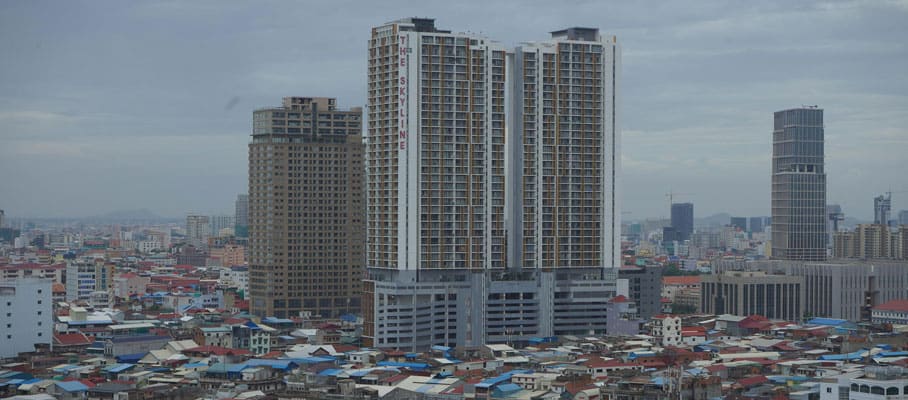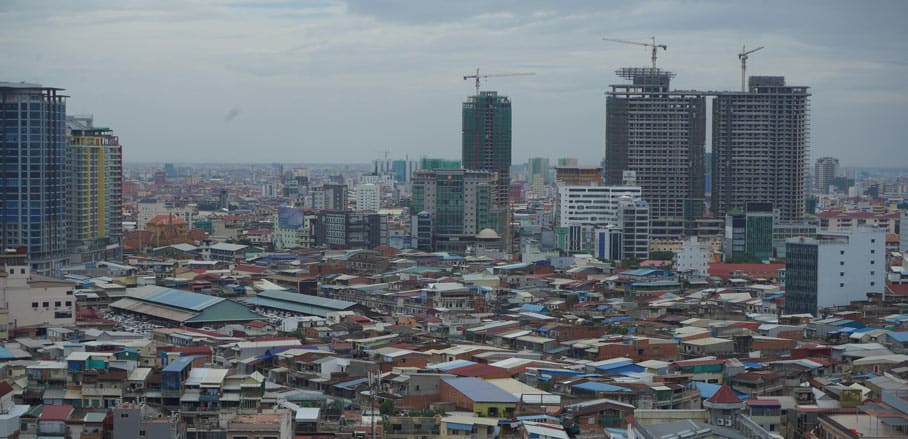What is the Affordable Housing Situation in Phnom Penh?
The municipality of Phnom Penh does not live up to its responsibility to provide affordable housing for all, says Ronan Kemp from Sahmakum Teang Tnaut Organization – A Cambodian Urban NGO.
Lingering at the margins of high-end construction projects, derelict housing and poverty characterise the spectacle that is Cambodia´s capital city of 2.3 million people. The housing situation in Phnom Penh is best described using terms like ‘exclusion’, ‘marginalisation’, or ‘unaffordability’. Private property developers, real estate tycoons, financial institutions, and back-door deals with the government have hijacked the affordable housing situation for most of the country’s urban poor. As Cambodia is entering a post-pandemic era, and restrictions are being lifted, the government is becoming increasingly vocal in trying to attract foreign real estate investment and reigniting dormant urban development projects throughout the city.
Some Attempts at Affordable Housing
The government has long been advocating for the need for affordable housing in Cambodia. However, there are only five approved affordable housing projects to date in the entire country, according to the Construction Ministry’s latest annual report. Phnom Penh only has two of these. The $70 million Arakawa condominium project is a residence in the Sen Sok district, which has recently completed its first phase, constituting almost 2,000 units; The Grand Park Housing Project, another residence in the Por Senchey district, is set to offer another 200 affordable housing units. Once completed, these residences will offer more than 3,000 units, Arakawa being the country’s first social housing project of this size and scale. The price per unit for both projects is set at around $30,000, in line with Cambodia’s housing affordability norms, which, according to the Construction Ministry, range from $15,000 to $30,000. Residents can sign up for monthly no-interest payment schemes, and this model is set to be replicated in the five affordable housing projects currently being built across the country.
While the government is demonstrating a certain willingness to provide the country’s urban poor with affordable housing options, it is clear that Phnom Penh’s urbanisation strategy prioritises beautification, foreign investment, and profit. This is seen through the multitude of high-end skyscrapers and residential construction projects such as Diamond Island – a new residential area by the Bassac river, where one square metre is priced between $2,500 and $3,500. Projects like these are driving gentrification and the exclusion of the urban poor from the city centre. As the city is pursuing its quest for beautification and prolific investments, the urban poor are once again left at the margins. The effects have been dire on the environmental front, the human rights front, and notably on the urban poor communities of the city, who are constantly vulnerable to forced eviction and harassment from local authorities.

A view of Phnom Penh’s rapidly evolving skyline © Sahmakum Teang Tnaut’
Transparency is Needed to Protect Citizens
Over the last two decades, 11 per cent of the city’s current population has been displaced, often forcibly, to poorer futures. In 2020, Sahmakum Teang Tnaut NGO (STT) monitored a community of 87 households, Banteay Sleuk, in the Boeung Keng Kang area. In June, as the pandemic was forcing governments across the world to implement lockdown measures, the community was approached by the Municipality of Phnom Penh (MPP) with the news that a construction project would be underway, causing their imminent eviction. On the 8th of July 2020, a meeting was held between the MPP and residents, and the community was granted plots of land – 4 x 15 metres, 30 kilometres away – per household, as well as a mere sum of $100. Their homes were destroyed quickly, not leaving them enough time to rebuild a new home at the new location. This case of forced eviction during a lockdown is a recurrent image demonstrating the government’s disregard for its urban poor. A study undertaken by STT shows that since 1990, over 270,000 people have been displaced or evicted from and within Phnom Penh.
‘Many communities continue to be at risk of eviction or live in areas where the law suggests they are unlikely to be provided with land titles. Forced eviction is a fear reported by many communities. Many families continue to struggle with low incomes and indebtedness, while the price of electricity and fuel has increased and remains high”, notes a study by STT.
Phnom Penh’s urban landscape is changing fast, and urban poor communities are set to experience further instances of eviction, and unfair compensation. Meagre attempts at affordable housing like the Arakawa condominium are still too few. Profit-hungry deals between government officials and foreign investors take precedence, often with no transparency, and undermine any attempt at pro-poor solutions. As forced evictions and a lack of legal accountability are still posing challenges to Cambodia’s urbanisation, the urban poor will continue to remain on the outskirts.
On paper, the role of the Municipality of Phnom Penh is to enforce and enshrine Cambodian laws, which currently only exist at the theoretical level. Authorities in Cambodia like the MPP should work to protect the rights of vulnerable Cambodian citizens in the context of insufficient affordable housing projects and hidden financial deals. Until this happens, affordable housing is yet to become a reality for most Cambodians.
- What is the Affordable Housing Situation in Phnom Penh? - 21. July 2022
